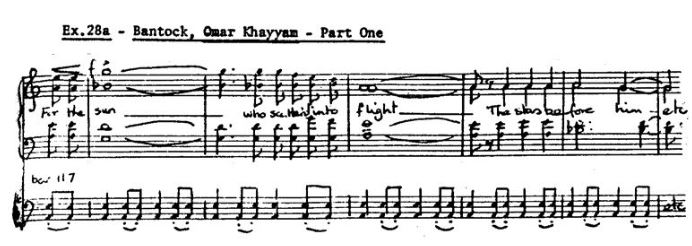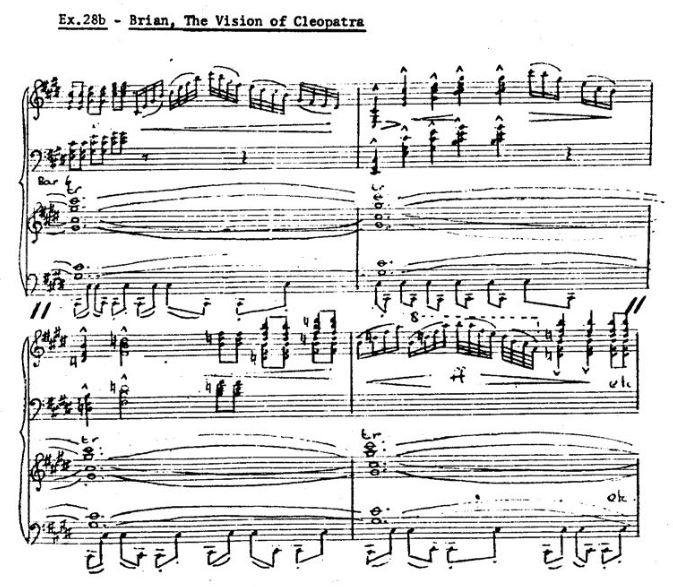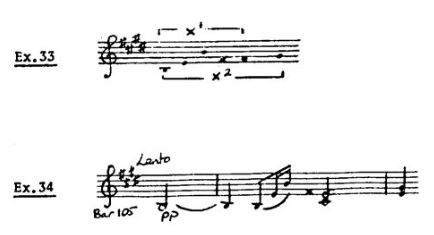Neil Starling
Malcolm MacDonald [1] draws attention to the “oriental” nature of much of the music. It is much more closely related to the “Eastern” elements of Bantock’s Omar Khayyam than to the “Jewish” melody of By the Waters of Babylon. In fact, the opening passage of The Vision of Cleopatra, which is probably the most clearly “oriental” passage in the work, has a direct parallel in Part One of Omar Khayyam.
It can be seen that in both passages there is a tonic/dominant pedal throughout, though whereas in the Bantock example both the dominant and the tonic are present in the rhythmic figure which occurs in the bass, in the example by Brian only the tonic is in the bass, while both tonic and dominant are held throughout the passage in the upper part of the texture. In both cases the harmonic progression is from the tonic of the key to the minor chord based on the flattened 7th, and back to the tonic. In the case of the example by Bantock the tonic chord is always lacking a 3rd, until bar 131, where the major 3rd (C#) is added. In the passage by Brian the tonic chord is always in the minor form, though the bare 5th is always prominent, being held throughout the section. The “oriental” flavour of this and other passages, coupled with intense chromaticism give this work a unique quality among Brian’s works, and was to date the most tonally ambitious piece, looking forward to his symphonies of many years later.
The Vision of Cleopatra can be divided into five main sections, the first being an orchestral prelude entitled “Slave Dance”, and the divisions of the other four sections being dictated by the text. Each of these sections can, however, be subdivided into scenes, each of which has its own thematic unity which makes it distinct from those before and after it. There is, nevertheless, a thematic thread which runs through the whole of the vocal part of the work, though the opening Slave Dance does not contain this motivic link. The Slave Dance begins with a 12-bar introduction based on the material presented in Ex.28b. The opening bars contain just the bare 5th (like the opening of so many of Brian’s works), the C# and G# as shown on the third stave of Ex.28b, then in the third bar the bass quaver figure joins in (the fourth stave of Ex.28b). At bar 13 the dance itself commences, still with the quaver bass figure. The D natural of the preceding 12 bars persists, continuing the “oriental” flavour (Ex.29).
The dance begins very softly and at a moderate tempo, but over the eighth bar Brian adds the marking “stately - gradually grow wild and riotous”. The music at this point is in fact a “wild” version of Ex.29 (Ex.30). The quaver figure in the bass has now become a triplet figure, while the melody has become more decorated. The alternation between C# minor and B minor chords returns, still over a tonic pedal. As the music intensifies with an in-crease in tempo and louder dynamic markings, there is also an increase in rhythmic complexity, with triplets and quintuplets appearing more and more frequently. The chromaticism becomes more intense as the music swells to a climax. At bar 56, Ex. 30 returns, now with the marking “wild and uneven”. At bar 70 the music begins to subside, returning at bar 73 to the music of Ex.29, now with the tempo indication of “Lento”. As the dance draws to a close the bass quaver figure becomes fragmented, leaving the bare 5th (C# and G#) as at the beginning.
The first vocal section, a solo for Iris (soprano), begins in E major, though the tonic chord contains an added 6th (C#), so the feeling of C# minor is still strong. In the first six bars of the solo there are two ideas present which are associated with Iris. The first is a dotted rhythm in the bass, fluctuating between the tonic and dominant, and the other is a more impassioned melodic fragment (Ex.31).
Six bars after Fig.8, at the words “She blooms with passionate ardour”, the work’s most important theme is presented. This is the motif which is connected with Cleopatra, and it first appears as a long melody, with a tremolando accompaniment above it, as Iris gives a description of her queen (Ex.32).
This is the only time the melody is heard in full. The first five notes of Ex.32 are the most important, creating a Tristanesque motif which appears in various guises throughout the work. There are two important elements in the motif; firstly the upward leap of a 4th then a 5th, and secondly the appoggiatura movement of the fourth and fifth notes. The motif appears on several occasions either without (X1) or with (X2) the resolution of the appoggiatura (Ex.33).
The last line of Iris’s aria is preceded by a version of X2 in one of its more recognizable forms (Ex.34). Usually the connection between a version of X and the original presentation of the theme is less obvious. The aria closes with a recapitulation of the two ideas associated with Iris, the dotted figure, and the melodic fragment given in Ex.31. As Charmion begins her aria (bar 115), new thematic material is presented, but after five bars the theme from the Slave Dance reappears, and, although it only lasts one bar, its presence continues to be felt, both in the repeated C# pedal of the work’s opening, and in the appearance of D natural in a C# minor context. The appearance of music associated with slaves gives us an idea of Charmion’s position in Cleopatra’s palace. While the elements of the Slave Dance continue, X1 makes an appearance, with the F## not resolving upwards an as appoggiatura, but falling to C#, then to B#. As with Iris’s aria, this section closes with the same material with which it opened.
Footnotes: [1] MACDONALD, M. Havergal Brian - Perspective on the Music. London, Triad Press, 1972, p.15.
© 1985 Neil Starling
Newsletter, NL 58, 1985






